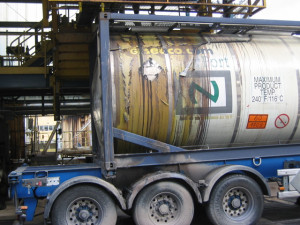A leak of toluene diamine (TDA) heated to 120 °C occurred during the unloading of a 23 t iso container towards the toluene diisocyanate (TDI) workshop supply area of a chemical plant. One technician burned his legs. Despite activating the emergency stop and closing the manual valve on the dip tube, the discharge lasted for 30 to 40 min, spilling 1,700 kg of TDA on the floor of the unloading area. An absorbent product was spread over the flows of molten TDA channelled by the rails of the tracks serving the sector, thereby limiting the spreading that was rapidly crystallising given the melting temperature of TDA (80 to 96°C). Whilst waiting for the spilled materials to be recovered which required the use of heavy equipment (pneumatic drills, etc.), synthetic material protections were placed over the affected area to prevent any risk of leaching by rainwater. Furthermore, the potential environmental impact of the accident was assessed through simulations and measurements taken on piezometers located downstream of the site.
Several contributory factors caused the accident: the leak started on the connector between the unloading hose (liquid phase) and the iso container which remained nitrogen pressurised (1.4 bar effective) while the unloading procedure stipulates its depressurisation beforehand. This type of container was temporarily used on the site because of the unavailability of the final iso containers. Therefore, in the absence of fixed connectors, a connection part had to be used. Insufficient tightening of this connector caused the assembly sealing fault. Furthermore, the iso container had not been depressurised because the unit’s sensor indicated a pressure below 50 mbar. Blocking of the container’s vent or closing of the gas circuit’s valve was without a doubt what caused this erroneous measurement which misled the technician.
Several corrective measures were implemented: systematic verification of the passage of nitrogen in the flowmeter during depressurisation and transmission of the flow measurement to the control box, manufacture of specific connection parts for use on the temporary containers, and installation of a pneumatic bolting machine at the unloading station to make the tightening of parts more reliable, etc.




